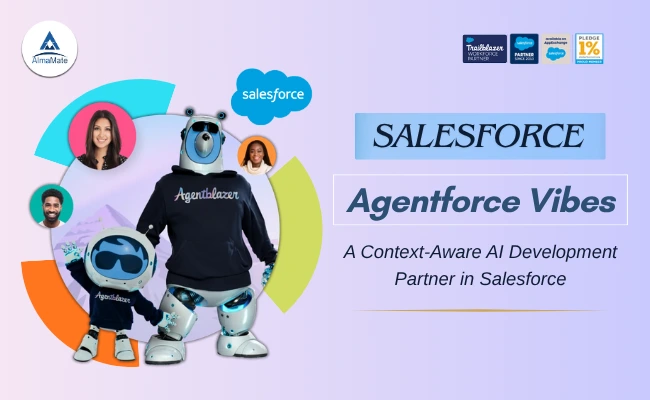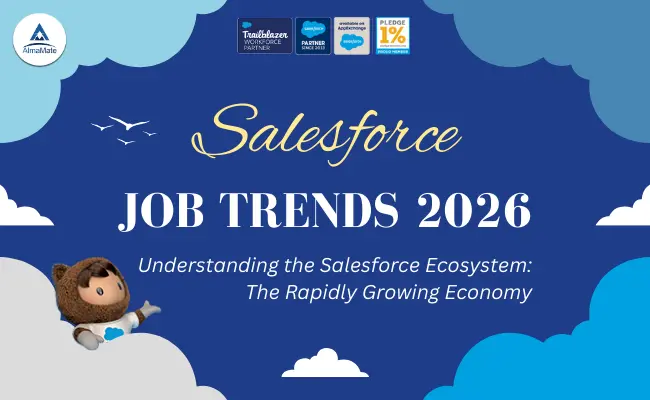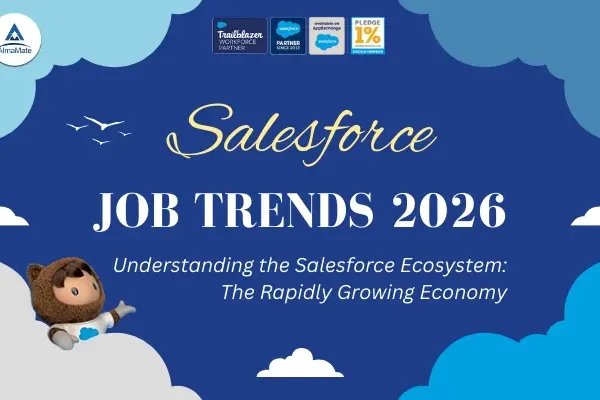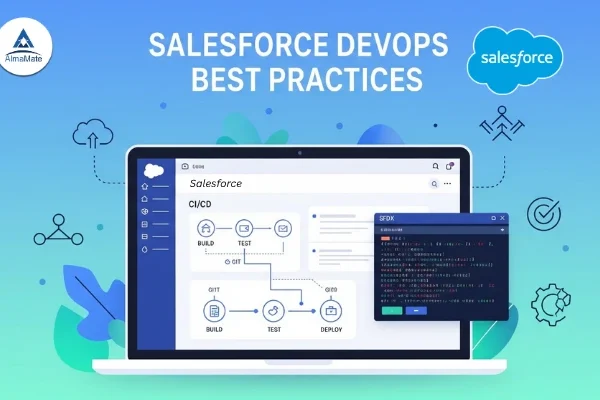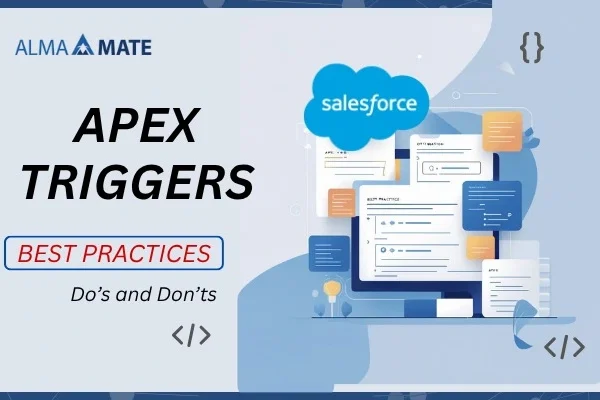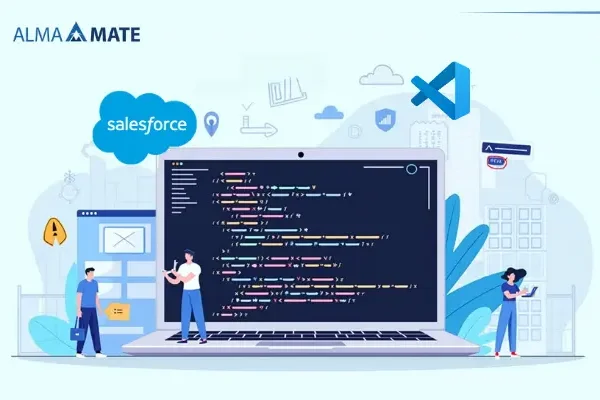
Table of Contents
Introduction: The Need for a New Development Paradigm
The world of software development is vast and exhausting. We spend an inordinate amount of time on repetitive, often tedious tasks—the boilerplate code, the configuration, the syntax checking—when our real value lies in solving complex business problems. For enterprise developers working on the Salesforce platform, this pressure is magnified multifold; every line of Apex or LWC must be bulk-safe, compliant with Governor Limits, and rock-solid from a security perspective. This is where the concept of Vibe Coding steps in, radically changing the development contract.
What is Vibe Coding?
Salesforce isn’t just bolting a generic AI tool onto their platform; they’ve introduced Agentforce Vibes, a strategic shift designed to treat AI not as a novelty, but as an integral, context-aware member of the development team. The term “Vibe Coding” itself speaks of this change. It moves beyond the clinical command-line instruction to a more human, high-level expression of intent. You’re no longer writing a class structure; you’re simply telling your agent what you want done, and letting the sophisticated agentic AI handle the heavy lifting.
Introducing Agentforce Vibes: A Context-Aware AI Development Partner
Think of Agentforce Vibes as having a supremely talented, hyper-focused junior developer who knows the Salesforce platform inside and out. You simply provide the high-level concept—the vibe—such as, “I need a Lightning Web Component that shows all open cases for the current user and highlights any that haven’t been touched in a week.” The beauty here is that the agent doesn’t just start spitting out JavaScript; it understands the wider implications. It knows the object schema, the correct API field names, the necessity of a corresponding Apex controller, and the absolute requirement for unit tests.
This capability is fueled by its deep integration into the Agentforce 360 Platform. Unlike general-purpose AI models that guess or use outdated information, Agentforce Vibes is constantly connected to your organization’s schema, custom metadata, and existing code base. This context is the magic ingredient. It ensures the output isn’t generic and bug-ridden; it’s perfectly tailored, using your team’s naming conventions and adhering to your architectural standards.
The Developer’s New Role: From Typist to AI Architect
The practical impact on the developer’s day-to-day life is immense. We spend less time hammering out getters and setters or wrestling with deployment packages, and more time actually thinking about the architecture and the user experience. Our role shifts from being highly paid typists to AI architects and validators. We become the strategic directors, guiding the AI to build the right solution and then applying our expert judgment to review its work for the most complex edge cases and business logic nuances.
The Shift from Traditional Coding to Vibe Coding
This tool is also built for immediate adoption, available right where developers live: either through a simple Visual Studio Code extension or via the Agentforce Vibes IDE (the cloud-based Code Builder environment). The lack of friction—no need to export code, paste it into an external AI window, or worry about context loss—makes Vibe Coding a seamless, organic part of the development flow. It’s a powerful statement: Salesforce is committing to a future where we ship features faster, not by working harder, but by working smarter alongside a highly capable AI partner.
It’s about going back to the joy of creative problem-solving, leaving the soul-crushing boilerplate in the past. Any developer knows that shipping fast is only half the battle; shipping high-quality, secure, and performant code is the real challenge to be addressed. Most AI coding assistants fail this test because they prioritize speed over compliance, which often involves the introduction of hidden flaws.
Deep Integration: Why Context Matters in Vibe Coding
The genuine value of Agentforce Vibes, and what elevates it to an enterprise tool, is how it systematically integrates quality checks into the coding process and synchronizes these. It’s like having a security analyst and a QA engineer looking over your shoulder at all times.
Enhancing Code Quality with Agentforce Vibes
The three main feature sets of Agentforce Vibes work together not just to speed up coding, but to actually improve the fundamental quality of the output, making the human developer better in the process:
- Contextual Code Completion: Beyond a Guessing Game. Forget the basic auto-completion you get from a generic IDE, which is useful but often feels like a guessing game. Vibe Code Completion is fundamentally different because it knows the entire Salesforce environment. When you start typing a method name, it doesn’t just throw out generic suggestions—it actually pulls up utility methods straight from your project’s Apex library, with the right parameter types already in place.
Why does this make such a big difference? Because you stop running into those annoying “wait, that’s not the right field API name” problems that slow everyone down. The suggestions fit your org’s exact setup. It knows your custom objects, your picklist values, and how everything connects. So, as you write code, it keeps nudging you toward smart, platform-specific practices and proven patterns. You get cleaner, more consistent code that your teammates can recognize right away. In the end, you spend less time cleaning up technical debt and more time actually building things.
- Code Analyzer Integration: The Proactive Security Shield. This is arguably the most critical feature for any security-conscious enterprise. In the past, running a static analysis tool was a separate, often delayed step that felt like a hurdle just before deployment. Agentforce Vibes turns that process into a real-time, active defense mechanism. The integrated Salesforce Code Analyzer scrutinizes code as it’s being written (or generated) for three major threats:
- Performance: Is this code bulk-safe? Will it hit a Governor Limit under high load?
- Security: Are there opportunities for SOQL injection? Is Field-Level Security properly enforced?
- Compliance: Does the code adhere to the organization’s style and complexity guidelines?
The best part? It’s not just flagging errors; it’s offering automatic fixes. If the AI detects a non-bulkified DML operation, it provides the correct, optimized version with a single click. This feature transforms the developer’s mentality from reactive debugging to proactive optimization, giving them immediate, actionable feedback that accelerates the learning curve and guarantees a higher baseline quality for every check-in.
- Code Explanations: Preserving institutional knowledge while keeping a big, complicated codebase running for years is tough. New people join the team and get lost in all the old logic, while senior devs end up rehashing decisions they made ages ago—stuff like, “Here’s why we did it that way back in 2018.” It’s a huge hit to productivity and drains your team’s collective memory. That’s where Code Explanations come in. They plug right into your IDE and use AI to spit out clear, easy-to-read summaries of even the messiest Apex methods or LWC logic. Suddenly, that tangled code makes sense.
You see what it does, how the data moves, and which business rules are baked in—all in plain language. This isn’t just convenient; it actually speeds up onboarding, makes code reviews smoother, and means you don’t have to track down someone who left the company years ago just to figure out what’s going on. By layering Vibe Code Completion, real-time analysis, and instant documentation, Agentforce Vibes creates a synergistic environment where faster coding is inseparable from higher quality.
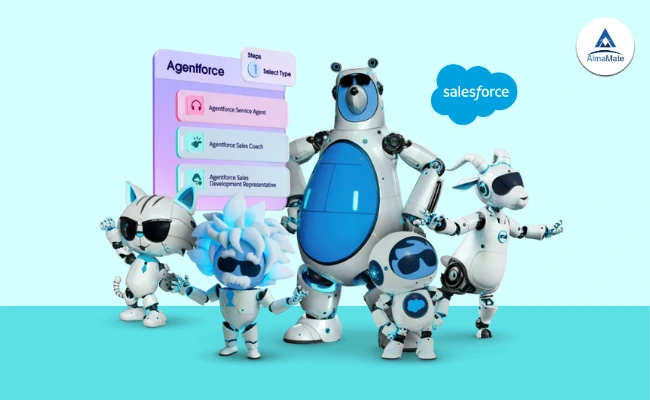
The Architecture of Trust: Eliminating AI Risks in Enterprise Development
In the enterprise space, you can’t simply ask an AI to write code without confronting the colossal issue of trust. CIOs and compliance officers immediately ask: Where does my proprietary data go? Is this code secure? Will we be audited? Most general-purpose AI coding tools fail this test because they expose sensitive information to external models. Salesforce built Agentforce Vibes to wipe out these risks, grounding the whole platform in the solid Salesforce Trust Layer. When it comes to security, Vibe Coding doesn’t mess around—it locks down privacy and governance, setting itself apart from the usual chaos you see with generative AI.
- The Zero-Retention Guarantee. The most fundamental assurance for the enterprise developer is the handling of data. When you input a prompt into Agentforce Vibes or allow it to analyze your schema, that data is not used to train public models, nor is it retained indefinitely. The system is configured to maintain an transient interaction model. After the AI handles your request—maybe it spits out some code, an explanation, or a fix—it immediately forgets everything about your prompt and the context you gave it. Your company’s internal logic and sensitive data aren’t hanging around on a server, waiting for someone to scoop them up or use them the wrong way. That’s because the Salesforce Trust Layer enforces a strict zero-retention policy. Thanks to this, even companies in tightly regulated fields like finance, healthcare, or government can trust Vibe Coding and use it without second-guessing their security.
- Guardrails: Keeping Data Inside the Trust Boundary. Crucially, all the powerful AI processing that drives Agentforce Vibes occurs within the Salesforce trust boundary. This is a physical and logical containment strategy. Your code and your data never leave the secure environment of the platform to be routed through external, third-party infrastructure. This architecture is the key to preventing the most feared scenario: data leakage. Enterprises can fully leverage the performance and contextual understanding of the AI without the existential worry that sensitive intellectual property will accidentally be exposed to the public or co-mingled with data received from other customers. It’s an enterprise solution built for enterprise-level risk mitigation.
Governance and Compliance: Safeguarding AI in Enterprise Environments
- Governance: AI That Complies with the Law: Agentforce Vibes keeps your team moving fast, but it doesn’t let you skip the important compliance stuff. It slides right into your usual Application Lifecycle Management routine, no fuss. Here’s the deal:
- Integrated Auditing: The tool keeps an eye on everything—every prompt you type in, every bit of code it generates. You end up with a complete audit trail, so you always have detailed records ready for security reviews or compliance reports. If regulators come knocking, you’ve got the proof.
- Pre-Deployment Vetting: All the code lands in version control and goes through your usual CI/CD pipeline, often through Salesforce DevOps Center. Nothing gets special treatment here. The AI’s code goes through the same human review, the same automated tests, and needs all the usual sign-offs—just like anything you’d write yourself.
Vibe Coding keeps developers in control. You get to look over the AI’s work, make changes, and only then does it go live. Let’s be real: everything’s speeding up, and developers feel that pressure more than ever. You’re supposed to build smarter and faster, but with fewer mistakes.
Agentforce Vibes in your Salesforce Enterprise Edition org
When Salesforce rolled out Agentvibes for free to Enterprise orgs and above, it didn’t feel like just another business move. It felt like a real nod to the people actually building things—a way of saying, “The AI revolution shouldn’t be locked behind a paywall, especially for the engineers shaping the future on this platform.” Picture a developer, up to the neck in Apex code or tackling a tricky Lightning Web Component. Every line matters—sometimes, the stakes are huge. One small change can impact a multi-million-dollar business process. It’s not just code; it’s responsibility.
This is where Agentvibes steps in—not as a replacement, but as a supremely talented, ever-present co-pilot. Built on Salesforce’s own AI models and the power of generative AI, Agentvibes is a sophisticated coding partner that lives right inside the developer’s favorite environment, Visual Studio Code. It’s the AI that can generate boilerplate code from natural language, offer inline code completions for complex logic, and even generate Apex unit tests to meet those critical code coverage requirements. For an enterprise, where scale and compliance are paramount, this translates directly into higher code quality and faster development cycles.
Here’s how you can roll out Agentforce Vibes in your Salesforce Enterprise Edition org
- First, please check if you’re eligible or not. Agentforce Vibes works with Developer and Enterprise editions. Just make sure there aren’t any region restrictions—some areas like the EU Operating Zone have specific limits. Even though you heard it’s free with Enterprise, double-check with your Salesforce account manager about what’s actually included, how long any trial period lasts, and what usage quotas you get.
- Next, set up your internal team to tackle a vast spectrum of challenges that may show up later. You’ll need a dev lead or an architect. Loop in your admin or security lead to handle governance and controls. It helps to have someone whose KRA is change management or training to get all the developers up to speed. Also, ensure that you have a sandbox or dev environment in place and ready for testing.
- Tackle governance and security in its nascent stages. Go through the official docs for guardrails—things like enterprise security, governance, and the trust layer. Figure out who gets access to Agentforce Vibes (which profiles or permission sets). If you want developers to self-serve, set up safe command lists and auto-approval rules. And don’t skip version control—Git’s a must here, especially since Agentforce Vibes ties into checkpoints.
- Get your environment ready. Double-check that your Salesforce CLI is up to date, you’ve got the right version of VS Code, and Git is installed. If you use scratch orgs or sandboxes, make sure Vibes runs smoothly there. Now’s the time to pick—do you want to use the web-based IDE, or do you prefer the Agentforce Vibes extension in VS Code? Your call. Now, turn on Agentforce Vibes in Salesforce. Go to Setup, search for “Agentforce Vibes”, enable it, and accept the terms. Deploy the extension in VS Code (or use the built-in IDE) and connect it to your org. Check that everything’s working—developers should see features like natural language code generation and test creation.
- Run a small pilot: Pick a straightforward, low-risk component to test—maybe have Vibes generate a basic Apex class and unit test from natural language instructions. Have a developer try something like, “Generate an Apex service class to handle invoicing and mock test data.” Review what comes out: the code, the tests, code coverage, and how it all deploys to your sandbox. Make sure it meets your standards for naming, security, and performance (the built-in Code Analyzer helps).
- Gather feedback and make adjustments. Ask your developers how it feels—is it easy to use? Is it speeding up their work? Is the code solid? Check in with admins and security folks for their take. If you need to adjust standards or commands—like naming conventions or patterns—update your internal docs and training.
- Roll out to everyone and operationalize. Map out your rollout: start with the pilot, then move to all dev teams, and finally, open it up org-wide. Set up training for everyone—developers, maybe admins too. Use internal sessions, docs, and Trailhead modules (Salesforce has them for Agentforce Vibes). Make it clear what’s available, how to get started, and where to go for help. Send any code Vibes generates through your usual CI/CD, code reviews, and deployment pipelines. Track usage: features built with Vibes, code coverage, defect rates, and hours saved. Keep an eye on usage caps—some setups limit you to 50 requests a day.
- Keep tabs on governance and monitoring: Schedule regular reviews of Vibes-generated code. Stick to your standards for maintainability and security. Monitor the usage, set up alerts so nothing gets out of hand, and keep your safe commands, permissions, and change logs up to date.
- Share training and best practices: Write up an internal SOP outlining when to use Vibes vs manual coding, best practices, and how to review generated code. Give clear instructions on writing prompts that work for Apex, LWC, and tests. Teach your devs how to maintain and refactor Vibes-generated code so it doesn’t become a black box.
- This is how building a feature with Agentforce Vibes actually goes. Someone from the business side comes in and says what they need—like, “Hey, I want customer service agents to update contact preferences right in the portal.” The dev lead jumps in and writes up a prompt: “Make a Lightning Web Component. It needs a form that grabs the contact with Apex, lets people change preferences, saves the changes, and then shows a confirmation.”
- Include unit tests for the Apex controller and Jest tests for the LWC.” A developer uses Agentforce Vibes in VS Code or the IDE, pastes in the prompt, and Vibes generates the Apex class, LWC code, and tests. The developer checks the generated code, tweaks it as needed, and gets the feature ready for deployment. That’s basically it. Once you’ve run the pilot and worked out the kinks, rolling out Agentforce Vibes across your org gets a lot smoother.

At the end of the day, Agentforce Vibes isn’t just a coding assistant—it’s a fully governed extension of your platform. It shifts the competitive advantage back to the developer by providing immense speed, while simultaneously reinforcing the enterprise’s commitment to security and regulatory compliance, making AI-augmented development not just fast, but genuinely trustworthy.
Thinking about implementing Agentforce capabilities in your Salesforce environment? Let’s Build It Together.
If the future of intelligent automation and Agentic AI excites you, now is the perfect time to partner with a team that can turn these possibilities into real business impact. At AlmaMate Info Tech, we combine deep Salesforce expertise with innovative problem-solving to help organizations build smarter, faster, and more scalable digital ecosystems. As a trusted Salesforce Development Company, we focus on delivering solutions that are strategically aligned with your long-term goals, ensuring every implementation adds measurable value.
Our end-to-end Salesforce Development Services cover everything from custom development and integrations to automation, analytics, and ongoing enhancements. Whether you are optimizing existing processes or preparing for a full transformation, our certified team ensures seamless execution with minimal disruption.
We also offer reliable Salesforce Consultancy to guide you through complexities, tailor the right architecture, and help you adopt emerging capabilities like Agentforce with confidence.
Partner with AlmaMate Info Tech today and accelerate your journey toward an intelligent, AI-driven Salesforce ecosystem that truly empowers your business.

